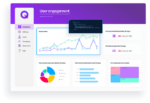
In the current age of digital transformation, data has emerged as the cornerstone of business operations. The rapid accumulation of information brings opportunities and challenges for organizations seeking to harness data’s potential. As evidenced by recent statistics from the Reveal survey, data-driven strategies are on the rise, with eight in ten software developers (80.8%) incorporating embedded analytics and business intelligence tools into their products. This trend reflects the growing recognition of the transformative power of data.
The Challenge of Data Abundance
Data is no longer scarce; instead, it has become an overwhelming flood that demands careful navigation. Organizations gather data from various sources, including customer interactions, market trends, operational processes, and more. This presents opportunity but also many challenges.
The biggest roadblock is transforming this raw data into meaningful insights that can guide decisions that can make or break a company.
The traditional data analysis approach can’t always address the complexities and speed of the modern business landscape. So, how can companies ensure they master collecting and analyzing data from various sources to gain insights into a problem or decision?
The answer for many of them is adopting decision intelligence.
What is Decision Intelligence?
Decision intelligence represents a paradigm shift that transcends the limitations of conventional data analysis. It involves a holistic approach incorporating advanced technologies, analytical methodologies, and a decision-centric mindset.
Decision intelligence focuses on extracting insights from data and optimizing decision-making processes, making them more efficient, precise, and aligned with business goals. The primary purpose of decision intelligence is to help individuals and organizations make more informed, data-driven decisions.
Some of the key elements of Decision Intelligence include:
- Data Collection and Analysis: Collecting and analyzing data from various sources to gain insights into different aspects of a problem or decision; this may involve traditional data sources, such as databases and spreadsheets, as well as newer sources like sensor data and social media.
- Predictive Modeling: Statistical techniques are often used to create predictive models that can forecast future outcomes or scenarios based on historical data and help decision-makers understand the potential consequences of their choices.
- Optimization: This may involve optimizing resource allocation, supply chain management, or other operational processes.
- Cross-Functional Collaboration: Successful implementation of Decision Intelligence often requires collaboration across different departments within an organization.
Ultimately, Decision Intelligence empowers organizations to make more effective, efficient, and responsible decisions and enhances decision-making in companies by integrating data, technology, and human expertise.
From Insights to Decision Intelligence: A 3-Step Guide
Here is a structured process to help you go from insights to Decision Intelligence and make informed decisions based on data-driven insights:
Step 1: Gather and Analyze Data
Collect relevant data from various sources, including internal databases, external market research, customer surveys, and other applicable data streams. Then, use tools to clean, process, and analyze that data. This step is crucial for uncovering meaningful insights.
Step 2: Generate Insights
Once you have analyzed the data, then you can identify patterns, trends, and key insights relevant to your decision-making process. Insights can include information about customer behavior, market dynamics, operational efficiency, or other aspects of your business.
Step 3: Use a Data-Driven Tool
Implement a tool that allows you to pull data from multiple sources and display it all together in dashboards, allowing you to understand aggregated data like never before. Data-driven work management tools are how teams access the data they accumulate. That way, they have it all in one place. Building dashboards that show you what is happening in real-time ensures your decision-making is based on the latest information.
Transitioning to Decision Intelligence
Shifting to Decision Intelligence is a gradual process for any business. It involves acquiring skills, adopting new tools, and most of all, embracing a data-driven mindset. As you gain experience and expertise, you’ll find that Decision Intelligence can lead to more informed and effective decision-making, ultimately enhancing your outcomes.
Here are steps you can take to make this transition effective:
- Identify the critical decision points in your work. These are moments where data and insights can influence your choices and outcomes.
- Start collecting data that is relevant to your work. This data can come from various sources, such as databases, spreadsheets, surveys, or external research.
- Use data analysis tools and techniques to extract insights from the data. This may involve basic statistical analysis, visualization, and data cleaning.
- Define clear objectives for your decisions. What are you trying to achieve? What outcomes do you expect? Having well-defined goals is crucial for effective Decision Intelligence.
- Choose software tools that can assist you in creating dashboards that visualize data, track performance, and display different scenarios.
- Continuously monitor and analyze the data related to your work. Look for patterns, trends, and anomalies that can inform your decisions.
- Decision Intelligence often requires collaboration with colleagues from different departments, such as data analysts, domain experts, and decision-makers. Foster a collaborative environment to share insights and knowledge.
- Present your findings and recommendations clearly to stakeholders in an understandable and compelling format.
The journey from insights to Decision Intelligence marks a transformative era in how organizations harness the raw power of data. Businesses can confidently navigate complexities by leveraging advanced technologies, fostering cross-functional collaboration, and embracing continuous learning. Decision Intelligence empowers organizations to make informed choices, optimize processes, mitigate risks, and thrive in an increasingly competitive landscape. As data continues to shape the future, Decision Intelligence remains essential for success.





